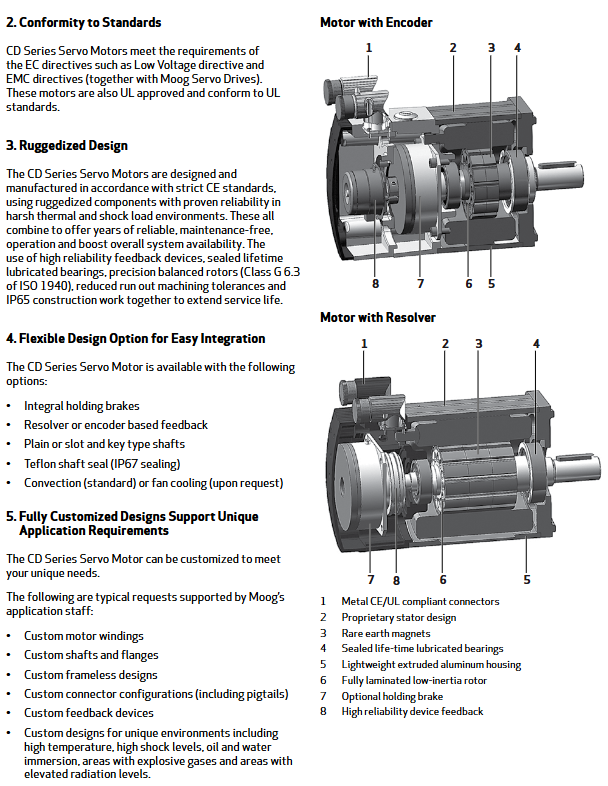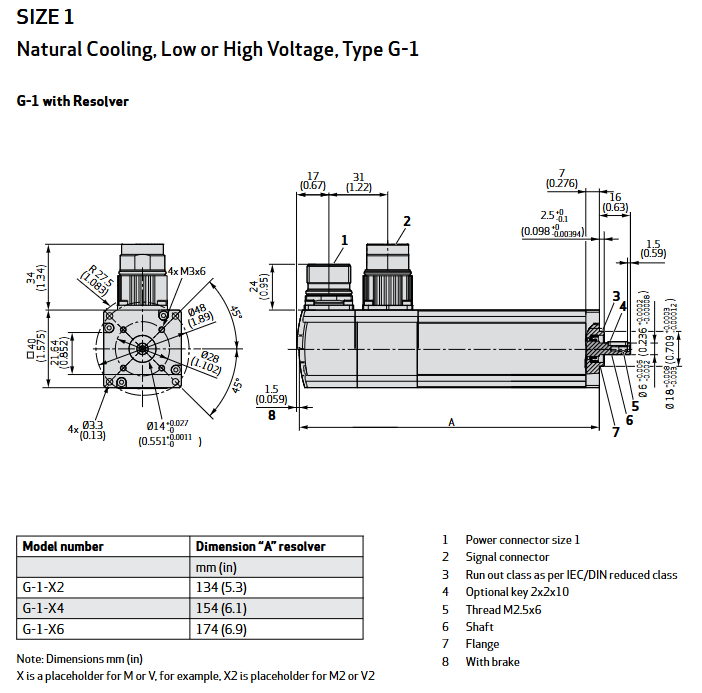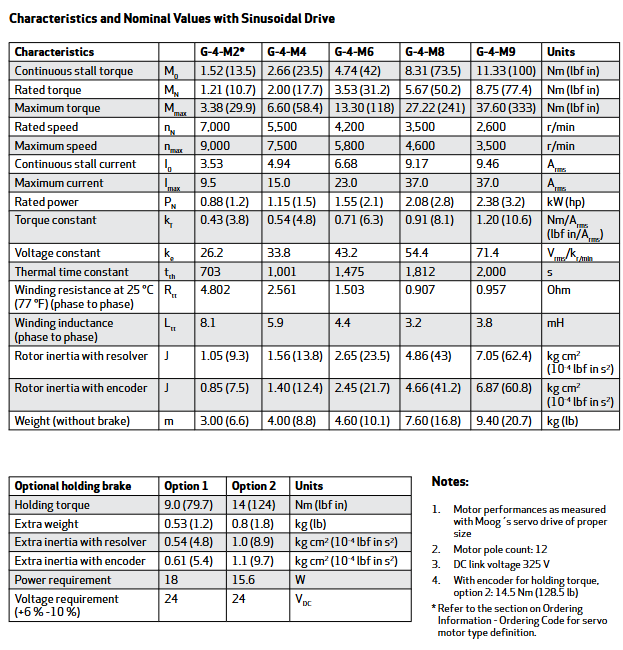Moog CD series compact dynamic brushless servo motor
Power density optimization: Compact body design (base size 40 mm-190 mm), combined with 8-12 pole electromagnetic structure, achieves high torque output in a small volume (such as the maximum continuous torque of 74.26 Nm for the G-6 model), saving equipment installation space.
Low cogging torque design: By using asymmetric stator slots, high pole layout, and proprietary magnetic circuit optimization, torque fluctuations during low-speed operation are reduced to ensure smooth operation (such as low-speed high-precision transmission for medical equipment and optical detection platforms).
Environmental adaptability: IP65 protection level (shaft seal optional IP67), working temperature -40 ℃~+125 ℃ (short-term reflow soldering withstand 240 ℃/15s), supporting industrial harsh environments such as high dust and humidity; Some models have passed explosion-proof certification and can be used in hazardous areas.
Moog CD series compact dynamic brushless servo motor
Core product positioning and technological advantages
1. Core features and applicable scenarios
High dynamic response: The rotor has a low moment of inertia (minimum 0.027 kg · cm ²), and the positioning time can be as low as within 30 ms, suitable for dynamic scenarios such as high-speed start stop and precision positioning (such as electronic component assembly robots and laser processing equipment).
Power density optimization: Compact body design (base size 40 mm-190 mm), combined with 8-12 pole electromagnetic structure, achieves high torque output in a small volume (such as the maximum continuous torque of 74.26 Nm for the G-6 model), saving equipment installation space.
Low cogging torque design: By using asymmetric stator slots, high pole layout, and proprietary magnetic circuit optimization, torque fluctuations during low-speed operation are reduced to ensure smooth operation (such as low-speed high-precision transmission for medical equipment and optical detection platforms).
Environmental adaptability: IP65 protection level (shaft seal optional IP67), working temperature -40 ℃~+125 ℃ (short-term reflow soldering withstand 240 ℃/15s), supporting industrial harsh environments such as high dust and humidity; Some models have passed explosion-proof certification and can be used in hazardous areas.
2. Key technological advantages
Dual voltage level adaptation: divided into low voltage version (G-X-M, DC 325 V, equipped with NTC temperature sensor) and high voltage version (G-X-V, DC 565 V, equipped with PTC temperature sensor), adapted to different servo drive power supply requirements, balancing low voltage safety and high voltage efficiency.
Flexible feedback options: Supports rotary transformers (Resolvers, 2-pole, strong anti-interference), incremental encoders (such as Heidenhain ERN series), and absolute encoders (single/multi turn, such as Stegmann SKS series) to meet different accuracy requirements from general positioning to precision closed-loop control.
Long life design: using lifetime lubricated sealed bearings, F-class insulated windings (temperature resistance of 155 ℃), coupled with rotor precision dynamic balancing (ISO 1940 G6.3 level), with a long mean time between failures (MTBF) and reduced maintenance costs.

Product series and technical parameters
1. Machine base size and performance range
The CD series is divided into 6 models (G-1 to G-6) according to the size of the machine base (flange diameter), and the core parameters of each model cover the following range:
Machine base model, flange size (mm), continuous torque range (Nm), maximum torque range (Nm), rated speed (r/min), rotor moment of inertia (kg · cm ²), weight (kg)
G-1 40 0.16-0.35 0.50-1.51 6000-9000 0.027-0.072 0.55-0.84
G-2 55 0.24-2.02 0.83-6.64 5000-8000 0.070-0.44 1.0-2.3
G-3 70 0.55-3.94 1.72-13.33 3400-11000 0.14-0.97 1.7-3.5
G-4 100 1.25-11.33 3.38-41.40 2600-8000 0.85-7.05 3.0-9.4
G-5 140 5.80-35.17 13.25-94.55 1800-5000 4.51-27.23 7.7-21.0
G-6 190 14.0-74.26 40.25-240.06 2000-4000 27.56-156.98 15.1-44.8
2. Key electrical and mechanical parameters
Electrical performance:
Torque constant (kT): 0.17 Nm/A~2.45 Nm/A (such as G-6-V9 model kT=2.27 Nm/A), high current control accuracy;
Voltage constant (ke): 11.1 Vrms/krpm~145.6 Vrms/krpm, adapted to the back electromotive force requirements at different speeds;
Insulation resistance ≥ 10 ¹² Ω, test voltage 1 kV~3.1 kV (higher for high voltage models), ensuring high voltage safety.
Mechanical properties:
Shaft diameter and keyway: adapted to the size of the machine base (such as G-1 shaft diameter of 6 mm, G-6 shaft diameter of 32 mm), supporting optical axis and keyway shaft (compliant with DIN 6885 standard);
Bearing load: Maximum radial load of 250 N (G-6), maximum axial load of 500 N (G-6), compatible with various transmission modes such as belts and gears;
Cooling methods: natural cooling (standard), forced air cooling (G-4~G-6 optional, increasing continuous torque by 30%).

Flexible configuration and customization options
1. Standard configuration options
The CD series motor supports multi-dimensional standard configurations to meet the needs of different application scenarios:
Braking device: Integrated permanent magnet holding brake (optional 2 torque levels), locks the shaft system after power failure, adapts to vertical axis loads (such as lifting platforms), braking voltage 24 VDC (power 10 W~40 W).
Shaft seal and protection: Standard IP65 (dustproof and waterproof), optional Teflon shaft seal (IP67), suitable for liquid splashing scenarios (such as food processing and cleaning equipment).
Connectors and Wiring: Supports right angle fixing, right angle rotation, and straight connectors, adapting to different installation space wiring requirements; The signal interface distinguishes between power (U/V/W) and feedback (Resolve/Encoder) for easy wiring maintenance.
Temperature monitoring: The low-voltage version is equipped with NTC thermistor (20.489 Ω at 25 ℃), and the high-voltage version is equipped with PTC thermistor (sudden change in resistance at 155 ℃) to monitor the winding temperature in real time and prevent overheating damage.
2. Customization capability
Moog provides deep customization services to meet the needs of special scenarios:
Winding customization: Customize winding parameters based on customer supply voltage (such as non-standard DC 400 V) and speed requirements (such as ultra high speed 15000 r/min), and optimize torque speed characteristics.
Mechanical customization: Customize shaft length, diameter (such as hollow shaft, spline shaft), flange size (such as adapting to customer equipment installation holes), and even frameless (no shell) design, integrated into customer motion mechanisms.
Environmental adaptation: High temperature coating (able to withstand temperatures above 200 ℃), explosion-proof design (ATEX II 3G), radiation resistant version, suitable for extreme environments such as aerospace and nuclear industries.
Feedback customization: Supports multi turn absolute encoders (such as Heidenhain EQN series), Hall sensors, or integrated speed generators to meet high-precision multi turn positioning requirements.
Selection and Application Guide
1. Core dimensions for selection
Load matching: Select the model based on the load inertia (recommended load inertia/motor inertia ≤ 5:1, high dynamic scenario ≤ 1:1), continuous torque, peak torque requirements, and motor torque speed curve (such as the G-4-M8 model with a continuous torque of 8.31 Nm at 3500 r/min).
Voltage and driver adaptation: The low voltage version (325 V) is suitable for small and medium power drivers, while the high voltage version (565 V) is suitable for high-power and high-speed scenarios, ensuring that the DC bus voltage of the driver matches.
Feedback accuracy: For general positioning, choose a Resolver (anti-interference), while for precise positioning, choose an absolute encoder (such as a 13 bit single loop+12 bit multi loop, with a resolution of 4096 × 4096).
Environmental parameters: IP67 shaft seal should be selected for humid/dusty environments, and the temperature resistance level of the winding should be confirmed for high temperature environments. Explosion proof certified models should be selected for hazardous areas.
2. Typical application scenarios
Industrial robots: G-2-G-4 models are used for robot joints, with low inertia supporting fast start stop and high torque density reducing joint volume;
Semiconductor equipment: G-1~G-3 models are used for wafer transfer robotic arms, with low cogging torque to ensure low-speed stability and IP67 protection suitable for clean room environments;
Precision machine tools: G-4~G-6 models are used for spindle or feed axis, combining high torque and high speed to meet high-precision cutting requirements;
Testing and simulation: The G-5~G-6 models are used for aerospace simulators, with high dynamic response and high reliability to support complex motion simulations.
Key points for installation and maintenance
1. Installation specifications
Mechanical installation: The flange needs to be fixed on a steel mounting plate of ≥ 300 × 300 × 25 mm (to ensure heat dissipation), and the axis alignment error should be ≤ 0.1 mm (to avoid excessive radial load);
Electrical connection: Separate the power line (U/V/W) from the signal line (feedback/braking) to avoid electromagnetic interference; The brake power cord needs to be supplied separately to prevent brake failure after the driver is powered off;
Heat dissipation design: Natural cooling motors require a reserved heat dissipation space of ≥ 50 mm, while forced air cooling motors must ensure that the fan inlet is unobstructed (fan voltage 24 VDC, current 1 A).
2. Maintenance suggestions
Regular inspection: Check the bearing noise and shaft seal sealing every 6 months, and shorten it to 3 months in high temperature environments;
Temperature monitoring: Monitor the winding temperature through the driver to avoid exceeding 110 ℃ for a long time (when the ambient temperature is 40 ℃);
Spare parts management: It is recommended to use spare brakes and bearings for key equipment, and Moog provides original factory maintenance services to ensure the shortest downtime.
Order Information
Model coding rules: For example, "G-4-V8" represents G-4 base, high-voltage version (565 V), and 8th stack length (corresponding to continuous torque of 8.31 Nm);
Standard accessories: including motor cables, installation screws, feedback interface manual. Customized models require information on load inertia, speed, environmental parameters, etc.

- EMERSON
- Honeywell
- CTI
- Rolls-Royce
- General Electric
- Woodward
- Yaskawa
- xYCOM
- Motorola
- Siemens
- Rockwell
- ABB
- B&R
- HIMA
- Construction site
- electricity
- Automobile market
- PLC
- DCS
- Motor drivers
- VSD
- Implications
- cement
- CO2
- CEM
- methane
- Artificial intelligence
- Titanic
- Solar energy
- Hydrogen fuel cell
- Hydrogen and fuel cells
- Hydrogen and oxygen fuel cells
- tyre
- Chemical fiber
- dynamo
- corpuscle
- Pulp and paper
- printing
- fossil
- FANUC
- Food and beverage
- Life science
- Sewage treatment
- Personal care
- electricity
- boats
- infrastructure
- Automobile industry
- metallurgy
- Nuclear power generation
- Geothermal power generation
- Water and wastewater
- Infrastructure construction
- Mine hazard
- steel
- papermaking
- Natural gas industry
- Infrastructure construction
- Power and energy
- Rubber and plastic
- Renewable energy
- pharmacy
- mining
- Plastic industry
- Schneider
- Kongsberg
- NI
- Wind energy
- International petroleum
- International new energy network
- gas
- WATLOW
- ProSoft
- SEW
- wind
- ADVANCED
- Reliance
- YOKOGAWA
- TRICONEX
- FOXBORO
- METSO
- MAN
- Advantest
- ADVANCED
- ALSTOM
- Control Wave
- AB
- AMAT
- STUDER
- KONGSBERG
- MOTOROLA
- DANAHER MOTION
- Bently
- Galil
- EATON
- MOLEX
- Triconex
- DEIF
- B&W
- ZYGO
- Aerotech
- DANFOSS
- KOLLMORGEN
- Beijer
- Endress+Hauser
- MOOG
- KB
- Moxa
- Rexroth


Email:wang@kongjiangauto.com
























































































































